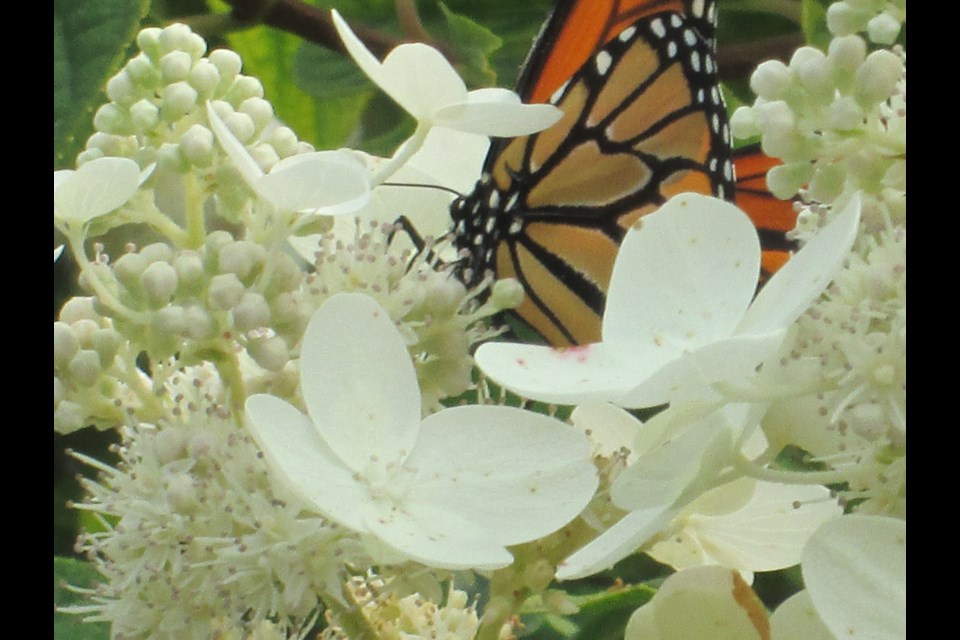Contributed by Pam McDermid
Our community is part of an amazing natural phenomenon: “In all the world, no butterflies migrate like the Monarchs of North America. They travel much farther than all other tropical butterflies, up to three thousand miles.” (Monarchwatch.com)
If you have a Monarch-friendly garden, (lots of milkweed) your participation began in late May. The great-grandchildren of the 2017 migration to Mexico came to our area to breed. Since then, many gardens have hosted several generations and now we’re seeing the 2018 migrants feeding for their journey to Mexico.
Their beauty is distinctive however, it is their life cycle and mass migration, that are most remarkable. Monarch butterflies have two distinctly different life expectancies, depending on the time of year they reach adulthood. Those that emerge from their chrysalis from June – early August live 2-5 weeks, to mate and lay eggs to build the population.
Monarchs emerging as summer ends, the “super generation”, live 7-8 months; during which they make the epic migration to Mexico, hibernate, breed and head north and lay the eggs for the next generation. They are also termed diapause Monarchs because they do not sexually mature until after migration and hibernation.
They fly in masses to the same winter roosts, somewhat like birds or whales; some Monarchs travel an astonishing 80 kilometres in a single day. But they make the trip only once; it is their children's great-grandchildren that return south the following autumn.
Thanks to the curiosity and dedication of scientists and everyday citizens, we know a great deal about the Monarchs and their lives. But, for centuries, residents of central Mexico where the overwintering grounds are located, were the ones who knew about the hibernation of the Monarchs.
Since pre-Hispanic times, Purépecha Indians have recorded the arrival of long, flowing clouds of orange-winged butterflies pouring into the Sierra Madre above the village of Angangueo, Michoacan.
The timing is unvarying :millions of Monarchs arrive at remote forest sanctuaries during the Purepecha’s Dia de los Muertos, (Days of the Dead, November 1 & 2) coinciding with the Christian holy days of All Hallow’s Eve, All Saints Day and All Souls Day (Oct. 31, Nov. 1 & Nov. 2).
This coincidence and blending of the Purepecha belief that human souls do not die, but rest until they return home to visit relatives, with the Catholic traditions of Saints and Souls days, resulted in the Monarchs being regarded as the souls of departed ancestors returning to Earth for their annual visit.
They hibernate in their millions, in the oyamel fir trees for three to four months. Numbers are measured in hectares of coverage of the forests. Records have been kept by Monarch Watch since 1994-95, when monarchs covered 7.81 hectares. Numbers fluctuate and there is ongoing concern about their survival.
By tagging butterflies, scientists, most notably Fred Urquhart of Toronto, were able to track the movement of the Monarchs and years of collaborative work by Canadian, American and Mexican scientists, finally revealed the flight paths and location of the high mountainous overwintering grounds. Hard to believe that these tiny creatures had flown so far, but when I visited El Rosario, the map of the tagged Monarchs origins showed one from Meaford!
The Monarchs come out of hibernation about mid February: the air is thick with them. They are now sexually mature and able to breed. Males die off and females fly north to lay their eggs around northern Mexico and southern Texas, subsequent generations proceeding further north to bring Monarchs back to our area.
Hoping to see the migration? They travel in ever-growing flocks, stopping along route. Point Pelee National Park is a resting point and can be a good viewing site.
The overwintering sites in Mexico are a truly awe-inspiring experience!
Luckily, it’s never too late to be part of this amazing, natural phenomenon.



